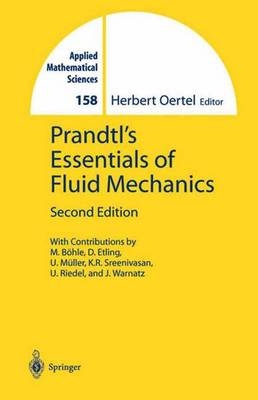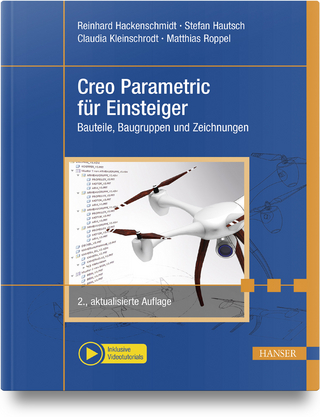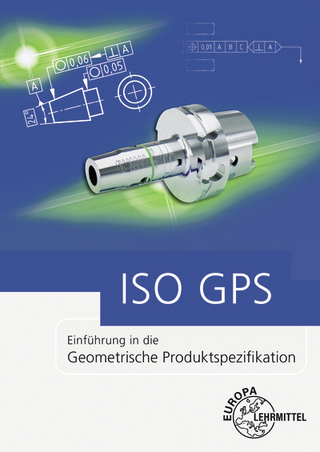
Prandtl's Essentials of Fluid Mechanics
Springer-Verlag New York Inc.
978-1-4419-2337-0 (ISBN)
- Titel erscheint in neuer Auflage
- Artikel merken
ContentsPreface 1. Introduction 2. Properties of Liquids and Gases 2.1 Properties of Liquids 2.2 State of Stress 2.3 Liquid Pressure 2.4 Properties of Gases 2.5 Gas Pressure 2.6 Interaction Between Gas Pressure and Liquid Pressure 2.7 Equilibrium in Other Force Fields 2.8 Surface Stress (Capillarity) 2.9 Problems 3. Kinematics of Fluid Flow 3.1 Methods of Representation 3.2 Acceleration of a Flow 3.3 Topology of a Flow 3.4 Problems 4. Dynamics of Fluid Flow 4.1 Dynamics of Inviscid Liquids 4.1.1 Continuity and the Bernoulli Equation 4.1.2 Consequences of the Bernoulli Equation 4.1.3 Pressure Measurement 4.1.4 Interfaces and Formation of Vortices 4.1.5 Potential Flow 4.1.6 Wing Lift and the Magnus Effect 4.1.7 Balance of Momentum for Steady Flows 4.1.8 Waves on a Free Liquid Surface 4.1.9 Problems 4.2 Dynamics of Viscous Liquids 4.2.1 Viscosity (Inner Friction), the Navier--Stokes Equation 4.2.2 Mechanical Similarity, Reynolds Number 4.2.3 Laminar Boundary Layers 4.2.4 Onset of Turbulence 4.2.5 Fully Developed Turbulence 4.2.6 Flow Separation and Vortex Formation 4.2.7 Secondary Flows 4.2.8 Flows with Prevailing Viscosity 4.2.9 Flows Through Pipes and Channels 4.2.10 Drag of Bodies in Liquids 4.2.11 Flows in Non-Newtonian Media 4.2.12 Problems 4.3 Dynamics of Gases 4.3.1 Pressure Propagation, Velocity of Sound 4.3.2 Steady Compressible Flows 4.3.3 Conservation of Energy 4.3.4 Theory of Normal Shock Waves 4.3.5 Flows past Corners, Free Jets 4.3.6 Flows with Small Perturbations 4.3.7 Flows past Airfoils 4.3.8 Problems 5. Fundamental Equations of Fluid Mechanics 5.1 Continuity Equation 5.2 Navier--Stokes Equations 5.2.1 Laminar Flows 5.2.2 Reynolds Equations for Turbulent Flows 5.3 Energy Equation 5.3.1 Laminar Flows 5.3.2 Turbulent Flows5.4 Fundamental Equations as Conservation Laws5.4.1 Hierarchy of Fundamental Equations 5.4.2 Navier--Stokes Equations 5.4.3 Derived Model Equations 5.4.4 Reynolds Equations for Turbulent Flows 5.4.5 Multiphase Flows 5.4.6 Reactive Flows 5.5 Differential Equations of Perturbations 5.6 Problems 6. Aerodynamics 6.1 Fundamentals of Aerodynamics 6.1.1 Bird Flight and Technical Imitations 6.1.2 Airfoils and Wings 6.1.3 Airfoil and Wing Theory 6.1.4 Aerodynamic Facilities 6.2 Transonic Aerodynamics 6.2.1 Swept Wings 6.2.2 Shock--Boundary-Layer Interaction 6.2.3 Flow Separation 6.3 Supersonic Aerodynamics6.3.1 Delta Wings 6.4 Problems 7. Turbulent Flows 7.1 Fundamentals of Turbulent Flows 7.2 Onset of Turbulence 7.2.1 Linear Stability 7.2.2 Nonlinear Stability 7.2.3 Nonnormal Stability 7.3 Developed Turbulence 7.3.1 The Notion of a Mixing Length 7.3.2 Turbulent Mixing 7.3.3 Energy Relations in Turbulent Flows7.4 Classes of Turbulent Flows 7.4.1 Free Turbulence 7.4.2 Flow Along a Boundary 7.4.3 Rotating and Strati.ed Flows, Flows with Curvature Effects 7.4.4 Turbulence in Tunnels 7.4.5 Two-Dimensional Turbulence 7.5 New Developments in Turbulence 7.5.1 Lagrangian Investigations of Turbulence 7.5.2 Field-Theoretic Methods 7.5.3 Outlook 8. Fluid-Mechanical Instabilities 8.1 Fundamentals of Fluid-Mechanical Instabilities 8.1.1 Examples of Fluid-Mechanical Instabilities 8.1.2 De.nition of Stability 8.1.3 Local Perturbations 8.2 Stratification Instabilities 8.2.1 Rayleigh--Benard Convection 8.2.2 Marangoni Convection 8.2.3 Diffusion Convection 8.3 Hydrodynamic Instabilities 8.3.1 Taylor Instability 8.3.2 Gortler Instability 8.4 Shear-Flow Instabilities 8.4.1 Boundary-Layer Flows 8.4.2 Tollmien--Schlichting and Cross-Flow Instabilities 8.4.3 Kelvin--Helmholtz Instability 8.4.4 Wake Flows 9. Convective Heat and Mass Transfer 9.1 Fundamentals of Heat and Mass Transfer 9.1.1 Free and Forced Convection 9.1.2 Heat Conduction and Convection 9.1.3 Diffusion and Convection 9.2 Free Convection 9.2.1 Convection at a Vertical Plate 9.2.2 Convection at a Horizontal Cylinder 9.3 Forced Convection 9.3.1 Pipe Flows 9.3.2 Boundary-Layer Flows 9.3.3 Bodies in Flows 9.4 Heat and Mass Exchange 9.4.1 Mass Exchange at the Flat Plate 10. Multiphase Flows 10.1 Fundamentals of Multiphase Flows 10.1.1 Definitions 10.1.2 Flow Patterns 10.1.3 Flow Pattern Maps 10.2 Flow Models 10.2.1 The One-Dimensional Two-Fluid Model 10.2.2 Mixing Models 10.2.3 The Drift--Flow Model 10.2.4 Bubbles and Drops 10.2.5 Spray Flows 10.3 Pressure Loss and Volume Fraction in Hydraulic Components 10.3.1 Friction Loss in Horizontal Straight Pipes 10.3.2 Acceleration Losses 10.4 Propagation Velocity of Density Waves and Critical Mass Fluxes 10.4.1 Density Waves 10.4.2 Critical Mass Fluxes 10.4.3 Cavitation 10.5 Instabilities in Two-Phase Flows 11. Reactive Flows 11.1 Fundamentals of Reactive Flows 11.1.1 Rate Laws and Reaction Orders 11.1.2 Relation Between Forward and Reverse Reactions 11.1.3 Elementary Reactions and Reaction Molecularity 11.1.4 Temperature Dependence of Rate Coefficients 11.1.5 Pressure Dependence of Rate Coefficients 11.1.6 Characteristics of Reaction Mechanisms 11.2 Laminar Reactive Flows 11.2.1 Structure of Premixed Flames 11.2.2 Flame Velocity of Premixed Flames 11.2.3 Sensitivity Analysis 11.2.4 Nonpremixed Counter.ow Flames 11.2.5 Nonpremixed Jet Flames 11.2.6 Nonpremixed Flames with Fast Chemistry 11.2.7 Exhaust Gas Cleaning with Plasma Sources11.2.8 Flows in Etching Reactors 11.2.9 Heterogeneous Catalysis 11.3 Turbulent Reactive Flows 11.3.1 Overview and Concepts 11.3.2 Direct Numerical Simulation 11.3.3 Turbulence Models 11.3.4 Mean Reaction Rates 11.3.5 Eddy-Break-Up Models 11.3.6 Large-Eddy Simulation (LES) 11.3.7 Turbulent Nonpremixed Flames 11.3.8 Turbulent Premixed Flames 11.4 Hypersonic Flows11.4.1 Physical-Chemical Phenomena in Reentry Flight 11.4.2 Chemical Nonequilibrium 11.4.3 Thermal Nonequilibrium 11.4.4 Surface Reactions on Reentry Vehicles 12. Flows in the Atmosphere and in the Ocean 12.1 Fundamentals of Flows in the Atmosphere and in the Ocean12.1.1 Introduction 12.1.2 Fundamental Equations in Rotating Systems 12.1.3 Geostrophic Flow12.1.4 Vorticity 12.1.5 Ekman Layer 12.1.6 Prandtl Layer 12.2 Flows in the Atmosphere 12.2.1 Thermal Wind Systems 12.2.2 Thermal Convection 12.2.3 Gravity Waves 12.2.4 Vortices 12.2.5 Global Atmospheric Circulation 12.3 Flows in the Ocean 12.3.1 Wind-Driven Flows 12.3.2 Water Waves 12.4 Application to Atmospheric and Oceanic Flows12.4.1 Weather Forecast 12.4.2 Greenhouse Effect and Climate Prediction 12.4.3 Ozone Hole 13. Bio.uid Mechanics of Blood Circulation 13.1 Fundamentals of Biofluid Mechanics 13.1.1 Respiratory System 13.1.2 Blood Circulation 13.1.3 Rheology of the Blood 13.2 Flow in the Heart 13.2.1 Physiology and Anatomy of the Heart13.2.2 Structure of the Heart 13.2.3 Excitation Physiology of the Heart 13.2.4 Flow in the Heart 13.2.5 Cardiac Valves 13.3 Flow in Blood Vessels 13.3.1 Unsteady Pipe Flow 13.3.2 Unsteady Arterial Flow 13.3.3 Arterial Branches 14. Thermal Turbomachinery 14.1 Fundamentals of Thermal Turbomachinery 14.2 Axial Compressor 14.2.1 Flow Coefficient, Pressure Coefficient, and Degree of Reaction 14.2.2 Method of Design 14.2.3 Subsonic Compressor 14.2.4 Transonic Compressor 14.3 Centrifugal Compressor 14.3.1 Flow Physics of the Centrifugal Compressor 14.3.2 Flow Coefficient, Pressure Coefficient, and Efficiency 14.3.3 Slip Factor 14.4 Combustion Chamber 14.4.1 Flow with Heat Transfer 14.4.2 Geometry of the Combustion Chamber 14.5 Turbine 14.5.1 Basics 14.5.2 Efficiency, Flow Coefficient, Work Coefficient, and Degree of Reaction 14.5.3 Impulse and Reaction Stage Selected BibliographyIndex
| Erscheint lt. Verlag | 3.4.2011 |
|---|---|
| Übersetzer | K. Mayes |
| Zusatzinfo | 530 black & white illustrations |
| Verlagsort | New York, NY |
| Sprache | englisch |
| Maße | 155 x 235 mm |
| Einbandart | Paperback |
| Themenwelt | Informatik ► Weitere Themen ► CAD-Programme |
| Mathematik / Informatik ► Mathematik | |
| Naturwissenschaften ► Physik / Astronomie ► Mechanik | |
| Naturwissenschaften ► Physik / Astronomie ► Strömungsmechanik | |
| ISBN-10 | 1-4419-2337-3 / 1441923373 |
| ISBN-13 | 978-1-4419-2337-0 / 9781441923370 |
| Zustand | Neuware |
| Informationen gemäß Produktsicherheitsverordnung (GPSR) | |
| Haben Sie eine Frage zum Produkt? |
aus dem Bereich


